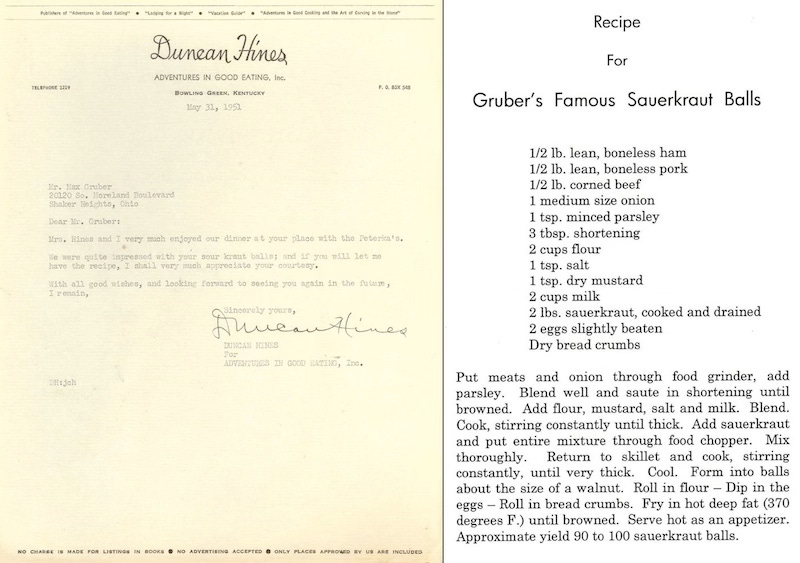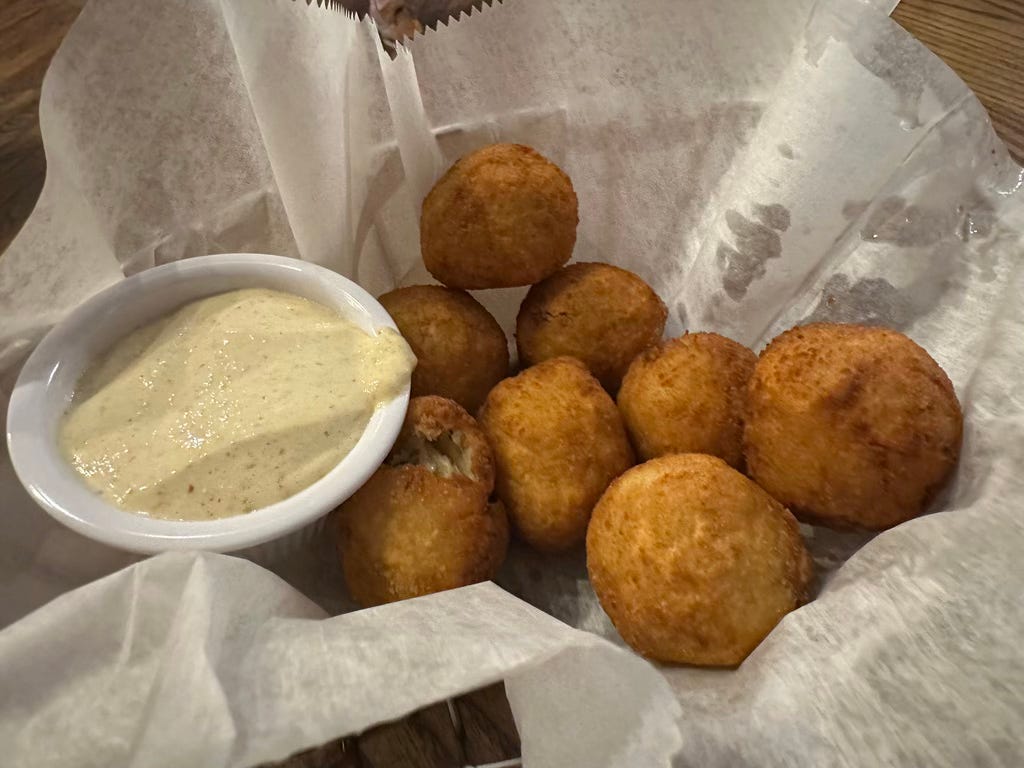Are Sauerkraut Balls an Ohio Original?
What do Akron, Duncan Hines and the Hey Hey Bar & Grill have in common? Sauerkraut balls.
A Dive into Ohio’s Sauerkraut Ball Lore
By Bethia Woolf
When people list off the regional specialties of Ohio, they might mention Cincinnati chili, goetta, Cleveland’s Polish Boys or Barberton chicken. They don’t usually talk about sauerkraut balls.
I hadn’t given much thought to the provenance of sauerkraut balls until a guest on a tour I was guiding mentioned they had never heard of them. The guest was from Pennsylvania, and the subsequent discussion made me realize that sauerkraut balls are very much a regional dish. As a Brit, perhaps I had assumed they had a wider sphere of influence? But thinking about it more, I hadn’t encountered them in other parts of the country. Were sauerkraut balls an Ohio original? I wanted to know more.
As I am wont to do (see: Columbus’ Chinese restaurant history or my deep dive into potato salad), I started delving into the history and geography of sauerkraut balls—digging through the Columbus Dispatch archives, consulting local historical society websites, perusing restaurant menus and recipe collections. I even asked Albert Thurn, Columbus’ king of German smoked meats, if he had grown up eating sauerkraut balls. His reply? “My father would never have adulterated sauerkraut.”
Most of our readers are based in Columbus and are presumably familiar with sauerkraut balls—but for the benefit of my parents and any other non-Ohio readers, let me explain…
Sauerkraut balls are small, round, breaded and fried orbs that resemble falafel or hush puppies. The filling is made from sauerkraut mixed with meat (often beef, pork or both), sometimes cheese, and usually onions and other seasonings. They’re a ubiquitous bar snack in Ohio, essential eating at Oktoberfests, and popular around the New Year, when sauerkraut is thought to be auspicious.
As German as they sound, sauerkraut balls appear to be an American invention. While they’re popular in cities with strong German heritage, there’s little evidence of them originating in Europe. My own research was supported by that of Judy Orr James, who wrote about sauerkraut balls in “Akron Family Recipes,” as well as Cincinnati-based food etymologist Dann Woellert. I combed Hofbräuhaus menus from around the globe—sauerkraut balls don’t appear on the menu at any of its German locations. In the U.S., only the Cleveland and Buffalo Hofbräuhaus locations serve them. Columbus, Pittsburgh and Cincinnati offer a variation: Reuben balls.
In Ohio, sauerkraut balls are most strongly associated with Akron, where they were named the city’s official food in 1996. Columbus author Thao Thai, writing in Eater, called the sauerkraut ball “northeastern Ohio’s answer to Proust’s madeleine.” But despite their popularity in Akron, the fried snacks are believed to have originated in Cleveland. As with many origin stories, there’s some opacity.
The first documented restaurant serving sauerkraut balls was Gruber’s, a popular German eatery in Cleveland founded in 1907 by Max Gruber and continued by his sons. According to Judy Orr James, Max’s son claimed his father created the fried delicacy with his chef as a way to avoid wasting food—reusing scraps of meat, breadcrumbs and sauerkraut.
In 1951, Duncan Hines dined at Gruber’s and later wrote to Max Gruber requesting the recipe. It was eventually published and syndicated in dozens of newspapers. Yes, that Duncan Hines. Before his name became synonymous with cake mixes, Hines was a traveling salesman who wrote travel guides and pioneered the restaurant-rating system for travelers along America’s “blue highways.” Gruber’s sauerkraut ball recipe included ham, pork and corned beef.
Sauerkraut balls also have a strong following in Cincinnati. According to Dann Woellert, restaurants like Mecklenburg Gardens and Lenhardt’s were serving them by the 1950s. The Cincinnati version differs from its Northern Ohio cousin by one controversial (at least to Akronites) ingredient: cream cheese. According to Woellert, Interstate 275 serves as a sort of Maginot Line—demarcating the state’s north-south divide in sauerkraut ball styles.
So, how and when did this bar staple end up on Columbus menus? The earliest mentions I found were from the late 1950s, when Dispatch readers wrote into the cooking column requesting recipes. The first restaurant menu reference I found was from Bavaria Haus, a restaurant on City Park in German Village, which was serving them in the 1970s. In 1977, you could enjoy a dozen sauerkraut balls there for just 95 cents.
I spoke with Sue Gall of the Hey Hey Bar & Grill, one of the Columbus spots best known for sauerkraut balls. Gall, who grew up in Dayton and went to Ohio State, has owned the Hey Hey for 45 years and added sauerkraut balls to the menu in 1982. Before that, she made them for parties. She had worked at the Emporium at the Continent where she had access to many cookbooks. She found a recipe and tweaked it. The Hey Hey now serves three versions: original, vegetarian and jalapeño.
At Barley’s Brewing Co. the kraut balls are known as Mildred’s Sauerkraut Balls. Mildred was a relative of the brewpub’s opening chef, and the spherical appetizers have been a popular menu staple since Barley’s opened in 1992. General manager Jason Fabien estimates that Barley’s sells about 25,000 a year. Barley’s uses Italian sausage along with Swiss cheese, garlic, onion herbs—and, of course, sauerkraut.
Sausage does seem to be the preferred meat in sauerkraut balls in Columbus. Schmidt’s uses bratwurst, while the Hey Hey and Byrne’s Pub both opt for pork sausage. Valter’s at the Maennerchor bucks the sausage trend with its house-made corned beef version.
Sue Gall also noted that the preferred dipping sauce varies by city—and within Columbus itself. At the Hey Hey, they’re served with horseradish sauce. Barley’s offers its version with Parmesan peppercorn ranch. Schmidt’s uses a creamy mustard sauce, while Valter’s employs horseradish mustard. In Cleveland, honey mustard is popular; in Cincinnati, it’s Düsseldorf mustard; and in Akron, cocktail sauce (gasp!) is the de rigueur pairing.
Where to Find Sauerkraut Balls (or Something Roundly Similar) in Columbus
Barley’s Brewing Co. (467 N. High St., Short North)
Byrne’s Pub (1248 W. Third Ave., Grandview)
Gemüt Biergarten (734 Oak St., Olde Towne East)
Hey Hey Bar & Grill (361 E. Whittier St., Merion Village)
Hofbräuhaus Columbus (800 Goodale Blvd., Grandview): The chain’s Reuben balls are made with sauerkraut, corned beef and Swiss cheese, then lightly breaded and fried and served with Thousand Island dressing.
Hubert’s Polish Kitchen (North Market, 59 Spruce St., Short North): Try the mielone, melty cheddar cheese wrapped in minced chicken and sauerkraut, with a crunchy panko crust.
Schmidt’s Sausage Haus (240 E. Kossuth St., German Village)
Valter’s at the Maennerchor (976 S. High St., Brewery District)
Weiland’s Market (3600 Indianola Ave., Clintonville): The grocery sells Akron’s most well known brand, Bunny B, which dates back to 1964.
LET US KNOW» Who makes the best sauerkraut balls in your book? Let us know in the comments.









Fantastic! Great deep dive. Who knew??
I thoroughly enjoyed this deep dive into saurkraut balls! I didn't realize they were such an Ohio thing and was surprised at how many restaurants in town serve them. Thanks for the investigative work! The reuben variation sounds particularly good. I'll have to give that one a try.